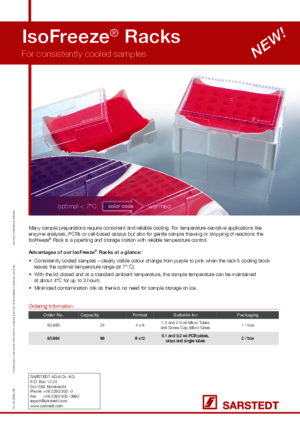
IsoFreeze® PCR-Racks
IsoFreeze® PCR-Racks
Language:
Some of the data collected by this provider is for the purposes of personalization and measuring advertising effectiveness.
We do not use cookies of this type.
Some of the data collected by this provider is for the purposes of personalization and measuring advertising effectiveness.
Some of the data collected by this provider is for the purposes of personalization and measuring advertising effectiveness.
We do not use cookies of this type.
Screw cap micro tubes and reaction tubes are essential for research and diagnostics. Our wide product range offers solutions for your day-to-day work.

Screw cap tube, working volume: 10 ml, (LxØ): 95 x 16 mm, material: LD-PE, conical wedge, translucent, screw cap, natural, cap assembled, with paper label, label/print: yellow, sterile, 1 piece(s)/blister

Rack, material: PC, transparent, format: 10 x 2, (LxWxH): 257 x 62 x 40 mm, for 20 collection tubes, suitable for screw cap micro tubes, 1 piece(s)/case
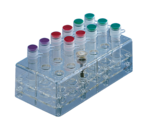
Rack, material: PC, transparent, format: 6 x 3, (LxWxH): 137 x 70 x 40 mm, for 18 collection tubes, suitable for screw cap micro tubes, 1 piece(s)/case
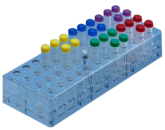
Rack, material: PC, transparent, format: 12 x 4, (LxWxH): 257 x 90 x 40 mm, for 48 collection tubes, suitable for screw cap micro tubes, 1 piece(s)/case
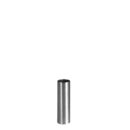
Decapper, for screw cap micro tubes, material: aluminium, 3 piece(s)/bag
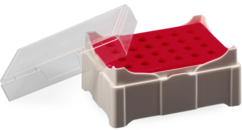
IsoFreeze® MCT Rack, material: PP, multi-coloured, format: 6 x 4, suitable for reaction tubes Ø 10.8 mm (1.5 ml & 2 ml), 1 piece(s)/case
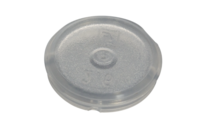
Colour-coded inserts, natural, PP, suitable for screw caps 65.712.xxx, 500 piece(s)/bag

Colour-coded inserts, red, PP, suitable for screw caps 65.712.xxx, 500 piece(s)/bag
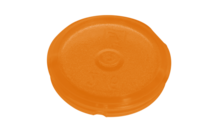
Colour-coded inserts, yellow, PP, suitable for screw caps 65.712.xxx, 500 piece(s)/bag
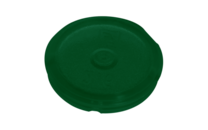
Colour-coded inserts, green, PP, suitable for screw caps 65.712.xxx, 500 piece(s)/bag


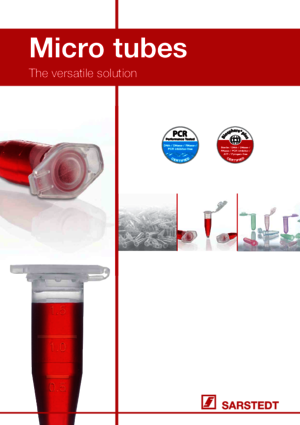
Our micro tubes can be centrifuged up to 20,000 x g. Tested with density solution (density: 1.06 g/ml) filled up to a nominal volume, at 20°C for 15 minutes in the fixed-angle rotor.
Our SafeSeal reaction tubes can be centrifuged up to 30,000 x g (2.0 ml up to 25,000 x g). Tested with demineralised water (density: 1.06 g/ml) filled up to a nominal volume, at 20°C for 90 minutes in the fixed-angle rotor.
Standard reaction tubes can be centrifuged at up to 20,000 x g. Tested with demineralised water (density: 1.06 g/ml) filled to nominal volume, at 20°C for 15 min. in a swing-out rotor. Our SafeSeal reaction tubes can be centrifuged at up to 30,000 x g (2.0 ml at up to 25,000 x g).
Screw cap micro tubes and reaction tubes can be autoclaved at 121°C without any appreciable loss of mechanical properties. When doing this it is important not to screw on/push down the cap to seal it. The user must check whether other product characteristics are affected by autoclaving in terms of the desired use.
The total length including the cap is 46.0 mm, with the cap attached it is 49.0 mm. The diameter underneath the mounting bundle is 10.8 mm. This means they can be used in most common microcentrifuges without any problems.
Our screw cap micro tubes have been used at temperatures below zero centigrade for decades. Based on our general experience, the screw cap micro tubes can be used to freeze aqueous solutions at temperatures of up to -86°C, except in the case of demineralised water (purified water) solutions. With demineralised water, there are generally critical freezing situations which can lead to the formation of cracks. Here, successful freezing of the tubes is always dependent on many factors. These include the medium to be frozen, the rack used and the mechanical load on the tubes. The use of tubes at temperatures below zero centigrade should therefore be tested under the routine conditions of the user.
For cryopreservation, we recommend using Sarstedt's CryoPure tubes.
The torque for caps for machine tightening should be between 15 and 18 Ncm.
All micro tubes type A, C, E, G and I can be provided with a 25 x 21.5 mm label in the factory. Depending on the requirements, the label can be printed individually and with different colours. Labels with all common barcode types can also be printed.
Since the labels are exposed to different stresses depending on the application – temperature fluctuations, contact with liquids and/or chemicals – labels and printing inks made of various different materials are available. The minimum purchase volume is determined individually.
The shipping of samples on dry ice is a common method, but we are aware of some problems associated with this type of shipping. When shipping in this manner, it is necessary to ensure that the tubes are packed so that they are protected as well as possible and appropriately fastened to avoid damage.

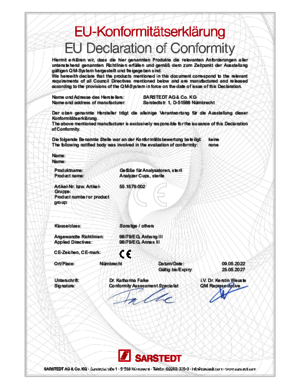
Please select your location, so that we can show you the product range relevant to your country / region.
